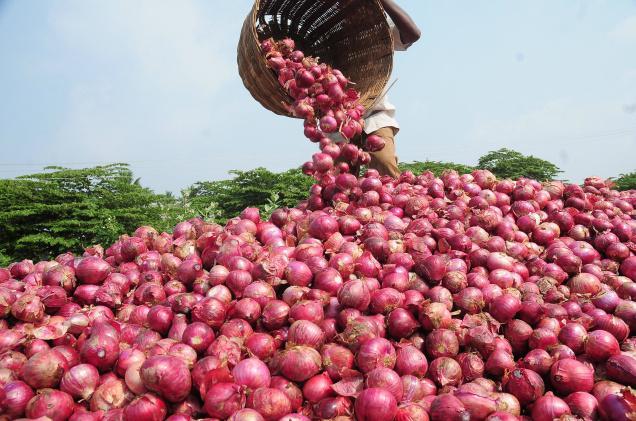
Abba Hamisu Sani
Africa-Press – Nigeria. Nigeria as the third largest producer of Onions in Africa and the threat of heavy lost due to poor storage.
Agricultural sector remains the major employment provider to the highest number of Nigerians as it contributes about 30 Percent of the country’s Gross Domestic Product (GDP).
Onions is one of the prominent items produced by Nigerian farmers that has high demand as it forms part of the major ingredients used for different nutritional purposes.
Nigeria is the third largest producer of onions in Africa, after Egypt and Tanzania. Similarly, according to the Food and Agriculture Organisation (FAO), Nigeria is the seventh largest producer in the world, accounting for about 10 percent of global production. As such, onion farming is a profitable agribusiness in Nigeria, contributing significantly to the Gross Domestic Product (GDP) of the country.
According to the United Nations sub organization FAO, Nigeria produced about 1.4 million metric tonnes of onions in 2019, making it the second largest producer in Africa after Egypt for that year.
The onion farming industry in Nigeria has a vast potential for exportation, particularly to the European Union Countries and the United States. This is in addition to local consumption through supply from the North to other parts of the country.
Onions Value chain challenges in Nigeria
However, despite all these potentials associated with onion farming, processing and marketing industry, the value chain is experiencing a regular challenge every year, top of which is poor storage facilities, which creates scarcity and price hike that further affects the general public and render stakeholders hopeless. This includes farmers who invest heavily to farm the produce but most times end up running at a loss.
Although the scarcity of the produce during off season usually leads to price hike, giving opportunities for higher profits, it also drops at a time farmers are harvesting, thereby leaving them with struggles to recover their capital without thinking of profit.
Findings reveal that instead of counting profit or getting back capital from the farmers they usually end up running at a loss, especially the smallholder farmers who sell their produce immediately after harvest, so buyers purchase at a cheaper rate.
Karfi Yan Albasa market is one of the major onion markets in Kano State which is the commercial hub of Northern Nigeria .Marketers at the area lamented over the fluctuating price of the produce, saying it had forced them to incur losses every year. They said the lack of improved and modern storage facilities, cost of transportation and cost of farm inputs had been the biggest challenges they faced in the business.
Speaking to the Nigeria newspaper Daily Trust recently one of the major dealers who has spent over two decades in the business, Muntari Isa Gamadan, said it was a large industry that accommodates thousands of people, including the elderly, youth and women.
He said that in their market alone, over 5,000 people earned a living on a daily basis.
On his part the national president of the National Onion Producers, Processors and Marketers Association of Nigeria (NOPPMAN), Alhaji Aliyu Maitasamu Isah, said Nigeria could generate as much as $420 million annually from exportation of onions if there was value addition.
Experts suggest the adoption of locally improved storage systems
Speaking on the possible ways out of the problem, the Director of the Agricultural Extension Department of the Kano State Agricultural and Rural Development Authority (KNARDA), Gambo Isa Garko, said the best way was to adopt a storage process that would make onions survive all year round.
“The crop is largely farmed during the rainy season, but that is not as strong as dry season onions. This is because of a lot of water. So, even in storage, the rainy season will not last as long as that of the dry season,” he explained.
According to him, research shows that in every 100 onions stored, 30 are always found rotten, leaving the owner with 70 pieces, a situation that reduces his profit or even capital.
Garko advised that farmers and marketers should adopt a locally improved storage that would allow the commodity to stay up to five months.
“This is by constructing a bed in the store so that onions will not be on the ground directly. It will be receiving ventilation from the top and ground.
“Government should also strive to provide improved storage for onions. However, it has started in Danbatta, where there is a storage facility called Artificial Onion Storage Crate Store by the APPEALS programme. But the best way is to adopt a system where the government will buy from farmers and store until it goes year round,” he added.
He also said there was the need for farmers to embrace new varieties that are resistant to excess water and can avert anything that may lead to rot easily. He advised them to seek advice at every stage of their farming process.
Processing plant births in Sokoto
The first onion and garlic flakes processing plant has been commissioned in Sokoto State.
The state is one of the major Onion producing areas in Nigeria
Speaking at the ceremony, the national president, National Onion Producers, Processors and Marketers Association of Nigeria (NOPPMAN), Aliyu Isa Maitasamu, said the plant would reduce 300 billion Naira post harvest losses to the barest minimum.
He said Nigeria produced two million metric tonnes of onions worth 700 billion Naira but about 40 percent of them, amounting to 300 billion naira perished due to lack of modern storage facilities and processing plants.
Maitasamu added that Sokoto alone produced 800,000 metric tonnes.
“We thank Onion and Garlic Processing Partnership Limited (O&G company) for coming to our rescue by establishing this processing plant,” he said.
Commissioning the plant, the director general of the Raw Materials Research and Development, Professor Hussaini Ibrahim, described the project as an important milestone for the manufacturing industry in the country.
He said the plant was designed and fabricated by Nigerian engineers following the call by the council to reduce the perennial post harvest wastages associated with onions and garlic.
“The council, in collaboration with Afri-Generoc Synergy Farms, Chimbilco Technical and Sokoto Investment and Property Company, had worked assiduously to achieve objective of processing onions and garlic into flakes on industrial scale following successful research and development by the council’s in-house research team,” he added.
Represented by one of the directors of the council, Ibrahim commended the partners and investors who made the project a reality.
The chairman of the company, Dr Saleh Ibrahim, said the idea was conceived by the educated elite to rescue onion and garlic farmers from perennial post-harvest losses. He said processed onion and garlic flakes would soon flood the markets.
For More News And Analysis About Nigeria Follow Africa-Press






